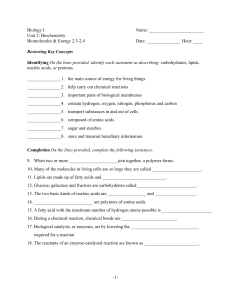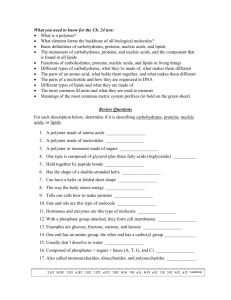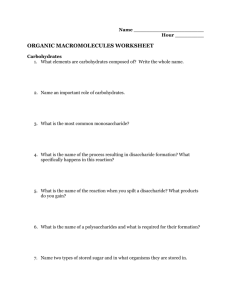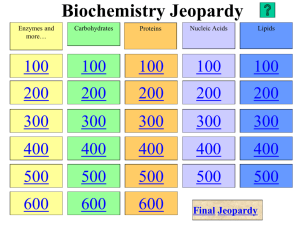Bio 21 Ch
advertisement
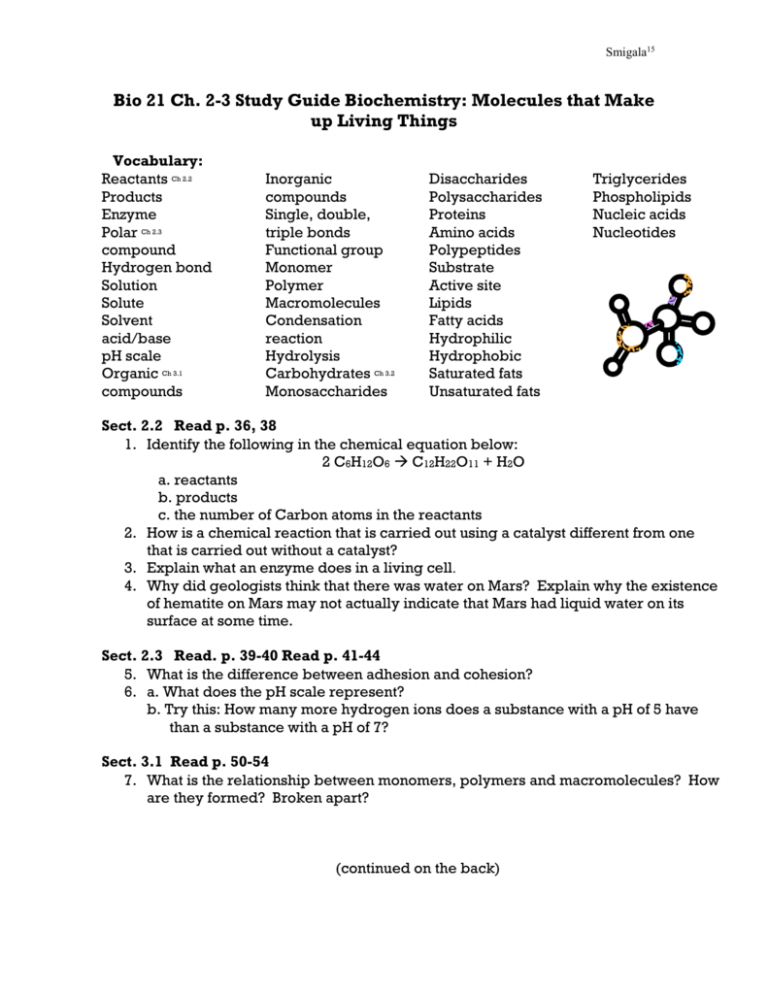
Smigala15 Bio 21 Ch. 2-3 Study Guide Biochemistry: Molecules that Make up Living Things Vocabulary: Reactants Ch 2.2 Products Enzyme Polar Ch 2.3 compound Hydrogen bond Solution Solute Solvent acid/base pH scale Organic Ch 3.1 compounds Inorganic compounds Single, double, triple bonds Functional group Monomer Polymer Macromolecules Condensation reaction Hydrolysis Carbohydrates Ch 3.2 Monosaccharides Disaccharides Polysaccharides Proteins Amino acids Polypeptides Substrate Active site Lipids Fatty acids Hydrophilic Hydrophobic Saturated fats Unsaturated fats Triglycerides Phospholipids Nucleic acids Nucleotides Sect. 2.2 Read p. 36, 38 1. Identify the following in the chemical equation below: 2 C6H12O6 C12H22O11 + H2O a. reactants b. products c. the number of Carbon atoms in the reactants 2. How is a chemical reaction that is carried out using a catalyst different from one that is carried out without a catalyst? 3. Explain what an enzyme does in a living cell. 4. Why did geologists think that there was water on Mars? Explain why the existence of hematite on Mars may not actually indicate that Mars had liquid water on its surface at some time. Sect. 2.3 Read. p. 39-40 Read p. 41-44 5. What is the difference between adhesion and cohesion? 6. a. What does the pH scale represent? b. Try this: How many more hydrogen ions does a substance with a pH of 5 have than a substance with a pH of 7? Sect. 3.1 Read p. 50-54 7. What is the relationship between monomers, polymers and macromolecules? How are they formed? Broken apart? (continued on the back) Smigala15 Sect. 3.2 Read p. 55-60 Be able to distinguish between the 4 types of organic compounds by structure and function. 8. Carbohydrates: a. Differentiate between mono, di and polysaccharides. b. What is the primary function of carbohydrates in cells? What are their other functions? c. Distinguish between the types of carbohydrates found in plant versus animal cells. 9. Proteins: a. What are the four functional groups in an amino acid? How do the amino acids bond together? b. What are the functions of proteins in cells? c. What role do environmental conditions (temperature & pH) play on the function of proteins? d. i. What is an enzyme? ii. What role to the substrate and active site play in enzyme function? iii. Is there just 1 kind of enzyme? 10. Lipids: a. Why are the properties of the two ends of a fatty acid so important to the function of a lipid in a cell? b. What is the primary function of lipids in cells? What are their other functions? c. Differentiate between saturated and unsaturated fats. d. Distinguish between the types of lipids found in plant versus animal cells. 11. Nucleic Acids: a. What are the 3 functional groups in a nucleotide? b. What are the functions of nucleic acids in cells? 12. Overall: a. Identify the chemical formulas for following functional groups: amino group, carboxyl group, hydroxyl group, phosphate group, and R group. b. ID which organic compound(s)- carbohydrates, lipids, proteins, nucleic acids they are found in. 13. Distinguish between type 1 and type 2 diabetes.
